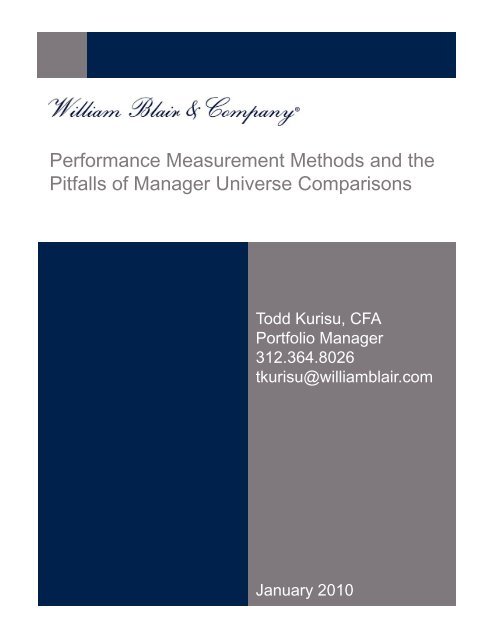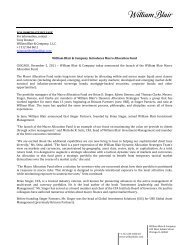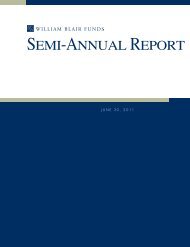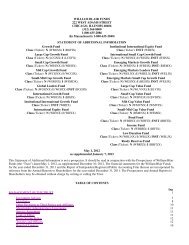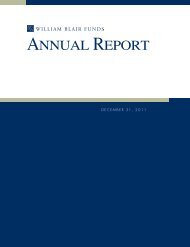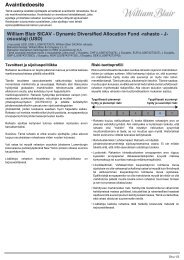Performance Measurement Methods and the Pitfalls ... - William Blair
Performance Measurement Methods and the Pitfalls ... - William Blair
Performance Measurement Methods and the Pitfalls ... - William Blair
Create successful ePaper yourself
Turn your PDF publications into a flip-book with our unique Google optimized e-Paper software.
<strong>Performance</strong> <strong>Measurement</strong> <strong>Methods</strong> <strong>and</strong> <strong>the</strong><br />
<strong>Pitfalls</strong> of Manager Universe Comparisons<br />
Todd Kurisu, CFA<br />
Portfolio Manager<br />
312.364.8026<br />
tkurisu@williamblair.com<br />
January 2010
ver recent years, we have seen many advances in risk measurement techniques, as well as<br />
O advances in investment strategies <strong>and</strong> investment offerings, but we have seen few notable<br />
advances in performance measurement techniques.<br />
As far back as June 1995, <strong>the</strong> Association of Investment Management <strong>and</strong> Research (AIMR), now called<br />
<strong>the</strong> CFA Institute, hosted a conference in which Michael Flynn, Manager - Stratford Advisory Group <strong>and</strong><br />
Jeffery V. Bailey, CFA, Managing Director – Richards & Tierney, discussed manager universes <strong>and</strong> peer<br />
group comparisons.<br />
Michael Flynn presented <strong>the</strong> proper construction <strong>and</strong> use of universes <strong>and</strong> peer groups.<br />
reasons for <strong>the</strong> popularity of <strong>the</strong>se metrics;<br />
He noted four<br />
1. Universes <strong>and</strong> peer group comparisons provide an actively managed benchmark<br />
alternative to a passive index benchmark.<br />
2. Clearly defined <strong>and</strong> effectively constructed universes <strong>and</strong> peer groups can be used to<br />
measure almost any well understood investment style.<br />
3. Portfolio-specific investment restrictions can be incorporated into a well constructed<br />
universe <strong>and</strong> peer group.<br />
4. Universe <strong>and</strong> peer group comparisons are conceptually easy to explain <strong>and</strong> underst<strong>and</strong>.<br />
Jeffery V. Bailey, CFA, discussed <strong>the</strong> shortcomings of manager universes <strong>and</strong> peer group comparisons.<br />
More specifically;<br />
1. Universe <strong>and</strong> peer group comparisons have conceptual shortcomings compared to an<br />
appropriate benchmark index.<br />
2. Universes <strong>and</strong> peer groups exhibit survivorship bias, which become more pronounced over<br />
longer time horizons.<br />
3. Manager universes are poor conveyors of a manager’s style.<br />
4. Manager universes <strong>and</strong> peer groups do not pass objective quality tests.<br />
Even though this conference presentation was in June 1995, <strong>the</strong> information presented is still relevant in<br />
today’s world. We have seen advances in more sophisticated techniques, such as performance<br />
attribution modeling. We have not, however, seen additional research on improving <strong>the</strong> universe <strong>and</strong> peer<br />
group ranking methodology that is employed by consultants <strong>and</strong> investors.<br />
All of Mr. Flynn’s points above still hold. In fact, many universes (including Morningstar <strong>and</strong> Callan)<br />
employ more clearly defined groupings than <strong>the</strong>y did 15 years ago. Theoretically, universes can employ<br />
portfolio-specific restrictions (such as sin-free restrictions or geographical restrictions), but in <strong>the</strong> fixed<br />
income marketplace, most of <strong>the</strong> universes are grouped by maturity/duration ranges (core bond,<br />
intermediate bond, short/low duration bond) or sector specifics (core plus, mortgage-backed securities,<br />
municipal bonds, emerging markets, high yield). For our purposes, <strong>the</strong> most relevant point that Mr. Flynn<br />
discussed is that universes <strong>and</strong> peer group rankings are easy to explain <strong>and</strong> underst<strong>and</strong>. This point<br />
cannot be understated, especially when discussing complex markets such as fixed income. Until <strong>the</strong><br />
market crisis in 2008/2009, we believe most investors didn’t fully appreciate <strong>the</strong> nuances of fixed income<br />
investing.<br />
Even with <strong>the</strong> recent market crisis behind us, we believe few fixed income investors truly underst<strong>and</strong> <strong>the</strong><br />
impact on performance of individual managers’ stylistic differences. While universe rankings provide an<br />
easy to underst<strong>and</strong> benchmark for evaluating a manager’s performance, it is imperative to underst<strong>and</strong> <strong>the</strong><br />
composition of <strong>the</strong> universe from which <strong>the</strong> rankings are derived.<br />
<strong>Performance</strong> <strong>Measurement</strong> <strong>Methods</strong> <strong>and</strong> <strong>the</strong> <strong>Pitfalls</strong> of Manager Universe Comparisons Page 1
Most fixed income universes are categorized by index or duration target. For example, a “Core Bond”<br />
universe may include all managers/funds with an investment style meant to outperform <strong>the</strong> Barclays<br />
Aggregate Bond Index or <strong>the</strong> Barclays Government/Corporate Index. This certainly seems reasonable<br />
when evaluating a mutual fund that is named “ABC Core Bond Fund.”<br />
The problem comes in when ABC Core Bond Fund invests meaningfully in non-index investments such as<br />
derivatives, leveraged instruments, non-agency mortgage-backed securities, high yield securities<br />
(including loans), emerging markets (including currencies), etc. Clearly a fund that invests in <strong>the</strong>se types<br />
of investments will exhibit a materially different risk profile than one that invests solely in high-grade, cash-<br />
only bonds, even though both may be benchmarked versus <strong>the</strong> Barclays Capital Aggregate Bond Index.<br />
An example of <strong>the</strong> perils of categorizing bond funds merely by benchmark objective was seen in <strong>the</strong><br />
recent market by investors in state-sponsored 529 plans in Illinois, New Mexico, Oregon, <strong>and</strong> Texas. All<br />
of <strong>the</strong>se plans offered a well known bond fund as <strong>the</strong>ir “Core Fixed Income” option. After producing a<br />
steady stream of performance that was better than <strong>the</strong> “median manager,” <strong>the</strong> fund’s performance started<br />
weakening in 2007.<br />
Historically, this fund emphasized mortgage-backed securities (including those non-index sectors<br />
previously cited) as a means for adding value. In 2008, <strong>the</strong> fund earned a -35.83% return. Clearly, this is<br />
not <strong>the</strong> performance expected by someone investing in a “Core Bond” fund. The fund has been party to<br />
numerous lawsuits as a result of this performance, <strong>and</strong> settlements have been agreed to in a number of<br />
<strong>the</strong>se cases. This is a clear example that universes can be a poor conveyor of a manager’s style, as Mr.<br />
Bailey presented in 1995.<br />
Recent Market <strong>Performance</strong> Attribution<br />
If we look at <strong>the</strong> last two calendar years (2008 <strong>and</strong> 2009), within any fixed income universe, we would see<br />
that those managers/funds that were <strong>the</strong> best performers in 2009 probably had a negative (<strong>and</strong> as we<br />
have seen, in some cases a double-digit negative) return in 2008.<br />
If we look at <strong>the</strong> market performance in 2008, we would see that few fixed income managers earned<br />
returns in excess of <strong>the</strong> Barclays Capital Aggregate Bond Index, which earned +4.58%, a top-quartile<br />
return in most consultant universes. Those fixed income managers that performed well in 2008 were<br />
those that invested heavily in U.S. Treasuries, as Treasuries were <strong>the</strong> only major market sector to earn a<br />
positive return in 2008. Most of <strong>the</strong>se managers probably emphasize duration strategy, ra<strong>the</strong>r than sector<br />
rotation or security selection, as a means to add alpha.<br />
As in our previous example, <strong>the</strong> worst-performing fixed income managers in 2008 were those that<br />
invested heavily in non-agency mortgage backed securities, including commercial mortgage-backed<br />
securities (CMBS), securities backed by sub-prime mortgages, <strong>and</strong> asset-backed securities (ABS) backed<br />
by home equity loans. Of course, all three of <strong>the</strong>se sectors were primary means for adding alpha versus<br />
<strong>the</strong> Barclays Aggregate Bond Index (which has/had limited exposure to any of <strong>the</strong>se sectors) prior to <strong>the</strong><br />
market collapse in September 2008.<br />
In 2009, with <strong>the</strong> help of government intervention, <strong>the</strong> markets rebounded sharply, <strong>and</strong> higher yielding<br />
(even distressed) securities rebounded more so than higher quality, lower yielding securities. In fact, in<br />
2009, <strong>the</strong> high yield <strong>and</strong> commercial mortgage-backed securities sectors both produced returns (58.2%<br />
<strong>and</strong> 28.5%, respectively) on par with common stocks! In both of <strong>the</strong>se years, structured products markets<br />
(non-agency mortgages, CMBS, ABS) exhibited an extreme lack of liquidity, which resulted in massive<br />
price swings in many of <strong>the</strong> underlying securities.<br />
<strong>Performance</strong> <strong>Measurement</strong> <strong>Methods</strong> <strong>and</strong> <strong>the</strong> <strong>Pitfalls</strong> of Manager Universe Comparisons Page 2
During <strong>the</strong> housing market boom, structured products produced incremental yield for fixed income<br />
investors with what seemed to be little incremental risk. In hindsight, we now know that investors in <strong>the</strong>se<br />
securities were assuming significantly more risk than <strong>the</strong>y had modeled. The markets once again taught<br />
<strong>the</strong> lesson that in <strong>the</strong> absence of real bids, valuations are subjective at best <strong>and</strong> liquidity non-existent.<br />
The Big Bond Bust<br />
In October 2009, Financial Analysts Journal Executive Editor, Richard Ennis, CFA, wrote an editorial<br />
entitled, “<strong>the</strong> Big Bond Bust”, in which he discussed <strong>the</strong> excessive risk taking allowed in recent years<br />
under <strong>the</strong> auspices of “core bond management. ” Mr. Ennis raises <strong>the</strong> point that <strong>the</strong> recent market<br />
reminded us that high quality fixed income investments remain <strong>the</strong> one <strong>and</strong> only true defense against loss<br />
in growth-oriented portfolios.<br />
The point is that more aggressive strategies certainly have <strong>the</strong>ir place in a well diversified investment<br />
portfolio, but probably not as <strong>the</strong> “core fixed income” component, which should be constructed more to<br />
provide protection in a bear market than to add growth in a bull market.<br />
Unfortunately for fixed income investors, merely selecting managers on <strong>the</strong> basis of top-quartile results or<br />
o<strong>the</strong>r peer group rankings can be misleading.<br />
As most manager universes are constructed merely segmenting managers/funds by <strong>the</strong>ir target<br />
benchmark index <strong>and</strong> not o<strong>the</strong>r risk measurements, it is clear that a “Core Bond Universe” will likely<br />
include managers that emphasize non-index sectors, interest rate timing/duration management strategies,<br />
sector rotation, security selection, <strong>and</strong> every o<strong>the</strong>r fixed income management strategy.<br />
Because of <strong>the</strong> broad range of strategies included in any universe, individual managers’ rankings will<br />
exhibit more volatility than o<strong>the</strong>r measures of relative performance. We <strong>the</strong>refore believe that in order for<br />
an individual manager to consistently earn top-quartile results in any universe or peer group, <strong>the</strong>y would<br />
have to have expertise not only in every fixed income discipline, but <strong>the</strong>y would have to time <strong>the</strong>ir<br />
decisions appropriately too.<br />
Winning Strategies<br />
As an example, if we think about <strong>the</strong> last two calendar years, most managers that earned top-quartile<br />
returns in 2008 were heavily invested in U.S. Treasuries <strong>and</strong> also held a longer-than-market duration in<br />
<strong>the</strong> last quarter of <strong>the</strong> year. These same managers, holding an overweight in U.S. Treasuries <strong>and</strong> a<br />
longer-than-market duration, no doubt would have underperformed materially in 2009 as both decisions<br />
would have worked against <strong>the</strong>ir relative performance.<br />
In order to maintain top-quartile performance in 2009, <strong>the</strong>se same managers would have had to shift out<br />
of Treasuries <strong>and</strong> into corporates (investment grade <strong>and</strong> below investment grade), emerging market debt,<br />
<strong>and</strong> commercial mortgage-backed securities, while lowering <strong>the</strong> portfolio’s overall duration. In addition,<br />
those decisions would have had to have been executed <strong>and</strong> in place by <strong>the</strong> end of <strong>the</strong> first quarter of<br />
2009, in order to fully benefit from <strong>the</strong> market rebound.<br />
While it may be possible for a bond manager to have <strong>the</strong> expertise to effectively manage all of <strong>the</strong>se<br />
strategies, <strong>and</strong> it may be possible for that same bond manager to be prescient enough toproperly p time<br />
<strong>the</strong>se decisions, we believe it is highly unlikely that a manager can do this effectively over multiple market<br />
cycles.<br />
<strong>Performance</strong> <strong>Measurement</strong> <strong>Methods</strong> <strong>and</strong> <strong>the</strong> <strong>Pitfalls</strong> of Manager Universe Comparisons Page 3
In fact, we believe that a manager that employed all of <strong>the</strong> possible strategies for fixed income<br />
management would quite likely have excessive portfolio turnover that would in itself degrade <strong>the</strong><br />
manager’s returns given <strong>the</strong> high cost of transacting in <strong>the</strong> over-<strong>the</strong>-counter fixed income market with<br />
bid/ask spreads ranging from a few basis points in high grade corporates to multiple points in sectors like<br />
high yield <strong>and</strong> emerging markets.<br />
A quick perusal of <strong>the</strong> Morningstar database for “Intermediate-Term Bond” funds would confirm that most<br />
of <strong>the</strong> managers that produced top-quartile returns in 2009 also earned negative returns in 2008.<br />
Following is a table that shows a list of 33 bond funds in Morningstar’s “U.S. Intermediate-Term Bond”<br />
category.<br />
YTD<br />
Rank<br />
Morningstar Category: US Intermediate-Term Bond. Returns Through 12/31/09 (Ranked by YTD Total Return)<br />
Total Return *Annualized (Net of Fees)<br />
Avg Avg Credit Credit Credit<br />
2008<br />
Exp.<br />
Name 1 Mo 3 Mo YTD 1 Yr 3 Yr* 5 Yr* 10 Yr* 15 Yr*<br />
Net Assets<br />
Ticker Eff Credit Qual Qual Qual<br />
Ret.<br />
Ratio<br />
Dur Qual BBB% BB% B%<br />
1 Putnam Income A 0.59 4.78 44.68 44.68 6.63 5.26 5.91 6.11 -20.32 679,144,394 0.99PINCX 5.48 AA 11.27 1.79 3.34 **<br />
Morningstar<br />
Rating<br />
2 MFS Bond A 027 0.27 282 2.82 28.40 28.40 616 6.16 501 5.01 656 6.56 683 6.83 -9.98 998 750,170,143 143 089MFBFX 0.89MFBFX 522 5.22 BBB 46.53 15.5151 392 3.92 **<br />
3 Western Asset Core Bond FI 0.04 3.04 23.37 23.37 3.66 3.71 6.12 6.67 -11.12 1,203,528,492 0.72WAPIX 4.23 AA 16.88 2.93 4.13 ***<br />
4 TCW Total Return Bond I -1.85 1.03 19.88 19.88 8.91 7.05 7.72 8.04 1.09 4,055,897,331 0.44TGLMX 2.90 A 2.20 2.70 10.50 *****<br />
5 Dreyfus/St<strong>and</strong>ish Fixed-Income I -0.50 1.93 18.32 18.32 5.22 4.59 6.01 6.48 -5.01 245,714,976 0.50SDFIX 4.11 AA 19.73 7.73 1.69 ***<br />
6 Neuberger Berman Core Bond Inst -0.61 2.04 18.15 18.15 5.77 4.98 6.07 -3.97 77,552,529 0.45NCRLX 4.32 AA 18.32 0.15 0.96 ***<br />
7 Bernstein Intermediate Duration -0.53 1.58 17.29 17.29 5.71 4.82 5.58 6.11 -4.43 5,238,919,931 0.57SNIDX 4.44 AA 19.92 2.70 2.31 ***<br />
8 BlackRock Total Return I -0.69 1.53 16.31 16.31 2.66 2.46 -11.31 455,652,827 0.58MAHQX 3.97 AA 6.50 9.00 0.00 **<br />
9 Dodge & Cox Income -0.10 1.76 16.05 16.05 6.60 5.40 6.81 7.20 -0.29 19,289,793,112 0.43DODIX 3.87 AA 10.55 2.65 1.26 ****<br />
10 Fidelity Investment Grade Bond -0.92 1.69 16.02 16.02 3.51 3.67 5.63 6.00 -7.12 6,228,391,182 0.46FBNDX 4.10 AA 19.30 4.90 0.80 **<br />
11 RiverSource Diversified Bond I -1.27 1.00 15.36 15.36 4.54 4.40 5.12 6.16 -6.07 853,520,485 0.47RDBIX 4.12 AA 16.39 4.08 1.34 ***<br />
12 American Funds Bond Fund of Amer A -1.05 1.12 14.91 14.91 1.39 2.38 4.89 5.99 -12.33 27,836,365,472 0.63ABNDX 4.19 AA 16.55 2.68 2.79<br />
**<br />
***<br />
13 MStar Cat: Intermediate-Term Bond -0.85 1.17 13.97 13.97 4.45 3.85 5.54 6.04 -4.70 0.95 4.37 AA 16.19 3.20 1.75<br />
14 Harbor Bond Instl -0.64 1.05 13.84 13.84 8.54 6.39 7.35 7.69 3.34 6,021,600,645 0.55HABDX 4.64 AA 4.18 0.22 0.33 *****<br />
15 PIMCO Total Return A -0.90 0.88 13.33 13.33 8.68 6.35 7.15 7.48 4.32 23,822,669,597 0.90PTTAX 4.79 AA 6.00 3.00 0.00 ****<br />
16 T. Rowe Price New Income -0.90 0.97 12.31 12.31 6.59 5.34 6.35 6.40 1.41 9,640,770,184 0.67PRCIX 4.27 AA 16.40 4.80 0.00 ****<br />
**<br />
17 Morgan Stanley Inst Core Plus FI Instl -0.97 1.25 11.62 11.62 -0.64 1.36 4.43 5.70 -16.42 841,842,059 0.49MPFIX 6.70 AA 15.40 1.93 0.17<br />
18 <strong>William</strong> <strong>Blair</strong> Bond Inst -1.10 1.10 11.47 11.47 1.95 16,252,006 0.35BBFIX 4.49 AA 12.40 2.30 2.60<br />
19 <strong>William</strong> <strong>Blair</strong> Bond I -1.11 1.05 11.40 11.40 1.72 127,740,489 0.50WBFIX 4.49 AA 12.40 2.30 2.60<br />
20 <strong>William</strong> <strong>Blair</strong> Bond N -1.22 0.93 11.11 11.11 1.64 3,586,083 0.65WBBNX 4.49 AA 14.40 2.30 2.60<br />
21 Baird Aggregate Bond Inst -1.20 0.97 10.88 10.88 4.57 4.28 -2.36 1,363,305,891 0.30BAGIX 4.43 AA 20.70 0.90 1.30 ***<br />
22 Payden Core Bond -1.35 0.77 10.73 10.73 5.28 3.98 5.94 6.29 -0.17 511,169,907 0.60PYCBX 4.50 AA 25.00 0.00 0.00 ***<br />
23 UBS US Bond A -027 -0.27 180 1.80 10.62 10.62 -124 -1.24 042 0.42 367 3.67 -14.21 8,593,161 085BNBDX 0.85BNBDX 439 4.39 AA 897 8.97 004 0.04 017 0.17 *<br />
24 SSgA Bond Market -0.95 0.99 9.66 9.66 -0.29 0.97 4.05 -1.86 42,653,073 0.50SSBMX 3.79 AA 12.84 0.11 0.00 *<br />
25 JPMorgan Core Bond A -0.96 0.76 9.52 9.52 6.69 5.18 6.40 7.17 3.79 2,938,878,239 0.75PGBOX 3.44 AAA 4.54 0.48 0.22 ***<br />
26 Allegiant Bond I -1.52 0.32 9.13 9.13 5.28 4.45 5.48 6.02 0.61 233,556,766 0.61AIGIX 4.31 AA 11.40 0.30 0.00 ***<br />
27 Calamos Total Return Bond A -1.32 0.33 8.17 8.17 5.85 98,033,359 0.83CTRAX 4.30 AA 18.90 1.80 0.00<br />
28 DWS Core Fixed Income A -1.49 0.20 7.32 7.32 -1.18 0.54 4.01 5.14 -14.34 295,741,955 0.80SFXAX 3.91 AA 18.00 0.00 0.00 *<br />
29 Oppenheimer Core Bond A -0.46 2.08 7.29 7.29 -10.40 -5.05 0.67 2.73 -35.83 371,460,181 0.90OPIGX 4.68 AA 8.53 4.39 2.57 *<br />
30 Nor<strong>the</strong>rn Fixed Income -1.27 0.62 6.91 6.91 4.97 4.18 5.43 5.93 3.90 1,127,490,573 0.90NOFIX 4.34 AA 16.24 0.00 0.03 ***<br />
****<br />
31 Vanguard Total Bond Market Index Inst -1.66 0.11 6.09 6.09 6.11 5.04 6.19 6.69 5.19 15,356,555,980 0.07VBTIX 4.27 AAA 8.09 0.00 0.00<br />
32 Index: BarCap US Agg Bond -1.56 0.20 5.93 5.93 6.04 4.97 6.33 6.80 5.24 4.57 AA 8.15 0.00 0.00<br />
33 MEMBERS Bond A -1.82 -0.35 2.68 2.68 4.30 3.73 4.86 5.36 43,773,631 0.90MBOAX 4.00 AAA 5.12 0.88 0.00 **<br />
Source: Morningstar, Barclays Capital Family of Indices, CMS BondEdge, <strong>William</strong> <strong>Blair</strong> Investment Management.<br />
Past performance is no guarantee of future results. Morningstar Ratings TM are as of 12/31/2009 <strong>and</strong> are subject to change every month. The ratings are based on a risk-adjusted return measure that accounts<br />
for variation in a fund’s monthly performance, placing more emphasis on downward variations <strong>and</strong> rewarding consistent performance. The top 10% of funds in each category receive 5 stars, <strong>the</strong> next 22.5%<br />
receive 4 stars, <strong>the</strong> middle 35% receive 3 stars, <strong>the</strong> next 22.5% receive 2 stars, <strong>and</strong> <strong>the</strong> bottom 10% receive 1 star. The overall Morningstar Rating for a fund is derived from a weighted average of <strong>the</strong><br />
performance figures associated with it three, five, <strong>and</strong> ten year (if applicable) Morningstar Rating metrics.<br />
In <strong>the</strong> box, we note 2009 (labeled “YTD”) return. In <strong>the</strong> middle column, we also show <strong>the</strong> 2008 calendar<br />
year return. We can clearly see that of <strong>the</strong> top 15 performers in 2009, 12 of <strong>the</strong> 15 bond funds earned<br />
negative returns in 2008. We also see that <strong>the</strong> top-performing bond fund in 2009 earned a -20.32% return<br />
in 2008. We believe this is not <strong>the</strong> type of performance thatt most investors expect when <strong>the</strong>y consider<br />
<strong>the</strong>ir “core fixed income” investments. The effect of this volatility on a universe <strong>and</strong> peer group ranking is<br />
that in any given year, <strong>the</strong> rankings are biased upward by funds taking higher levels of risk.<br />
<strong>Performance</strong> <strong>Measurement</strong> <strong>Methods</strong> <strong>and</strong> <strong>the</strong> <strong>Pitfalls</strong> of Manager Universe Comparisons Page 4
Survivor Bias<br />
In addition to this inherent volatility of peer group rankings, Mr. Bailey <strong>and</strong> o<strong>the</strong>rs have pointed out that<br />
survivor biases exist in any universe because underperforming managers close shop or have <strong>the</strong>ir funds<br />
absorbed into better performing funds, so only <strong>the</strong> surviving managers/funds are included in <strong>the</strong> universe<br />
data for any given time period. This results in an upward bias in <strong>the</strong> universe peer group rankings.<br />
Using <strong>the</strong> Morningstar database, we calculated <strong>the</strong> cumulative, annual returns for <strong>the</strong> median manager for<br />
<strong>the</strong> Intermediate-Bond Category by arithmetically linking (<strong>and</strong> <strong>the</strong>n annualizing) <strong>the</strong> annual returns. The<br />
linked median manager return for <strong>the</strong> three-year <strong>and</strong> five-year periods was 4.59% <strong>and</strong> 3.90%,<br />
respectively. These results are each more than 30 basis points lower than <strong>the</strong> median manager return<br />
reported by Morningstar for each of <strong>the</strong>se periods ended December 31, 2009, which was 4.93% <strong>and</strong><br />
4.26%, respectively. The difference between <strong>the</strong> two can be attributed to <strong>the</strong> difference in <strong>the</strong> universe<br />
constituents from year to year.<br />
In order to confirm this <strong>the</strong>sis, we looked at all of <strong>the</strong> constituents in <strong>the</strong> Morningstar database. As of<br />
year-end 2009, <strong>the</strong>re were 1,128 individual share classes (any one fund may include multiple share<br />
classes). This total number is roughly consistent with 2007, when <strong>the</strong>re were 1,155 share classes in <strong>the</strong><br />
same category. When we look at <strong>the</strong> individual years, however, we see that <strong>the</strong> number of funds that<br />
dropped out (ei<strong>the</strong>r because of liquidation or being acquired) were meaningful with 82 share classes<br />
eliminated in 2008 <strong>and</strong> 92 in 2009. If we also remove <strong>the</strong> number of new share classes launched, which<br />
numbers 128 in 2008 <strong>and</strong> 100 in 2009, we see that only 73.8% of <strong>the</strong> original constituents in 2007 still<br />
existed at <strong>the</strong> end of 2009.<br />
Clearly, high turnover exists among <strong>the</strong> constituents in any universe, <strong>and</strong> we believe this turnover results<br />
in an upward bias of periodic returns for <strong>the</strong> universe. In <strong>the</strong> case of <strong>the</strong> Intermediate Bond category, a<br />
30+ basis point annual difference is a meaningful impact to a core bond manager’s total return.<br />
Conclusion<br />
Over <strong>the</strong> last three years, <strong>the</strong> bond market has given us a remarkable period in which to evaluate<br />
individual managers <strong>and</strong> <strong>the</strong> merits of various strategies. The market volatility that started in 2007 gave<br />
way to one of <strong>the</strong> biggest market crises since <strong>the</strong> Great Depression. This unprecedented volatility allows<br />
for investment advisors <strong>and</strong> consultants to better underst<strong>and</strong> <strong>and</strong> quantify fixed income portfolio risks.<br />
Given <strong>the</strong> pitfalls of using universes <strong>and</strong> peer group rankings, investment advisors would be wise to<br />
incorporate o<strong>the</strong>r metrics when evaluating fixed income managers, <strong>and</strong> in so doing we believe <strong>the</strong>ir clients<br />
will be better served by having a stronger underst<strong>and</strong>ing of <strong>the</strong> risks <strong>the</strong>y are assuming in <strong>the</strong>ir portfolios.<br />
<br />
PAST PERFORMANCE IS NOT INDICATIVE OF FUTURE RESULTS. THIS IS NOT IN ANY SENSE A SOLICITATION OR<br />
OFFER OF THE PURCHASE OR SALE OF SECURITIES. THE FACTUAL STATEMENTS HEREIN HAVE BEEN TAKEN FROM<br />
SOURCES WE BELIEVE TO BE RELIABLE, BUT SUCH STATEMENTS ARE MADE WITHOUT ANY REPRESENTATION AS<br />
TO ACCURACY OR COMPLETENESS OR OTHERWISE. OPINIONS EXPRESSED ARE OUR OWN UNLESS OTHERWISE<br />
STATED.<br />
<strong>Performance</strong> <strong>Measurement</strong> <strong>Methods</strong> <strong>and</strong> <strong>the</strong> <strong>Pitfalls</strong> of Manager Universe Comparisons Page 5


